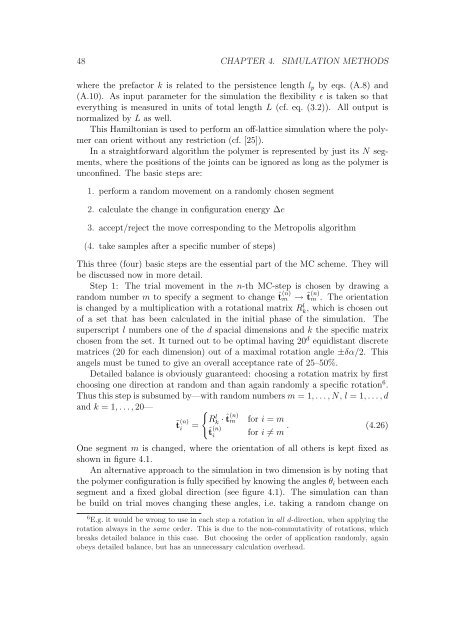Polymers in Confined Geometry.pdf
Polymers in Confined Geometry.pdf
Polymers in Confined Geometry.pdf
You also want an ePaper? Increase the reach of your titles
YUMPU automatically turns print PDFs into web optimized ePapers that Google loves.
48 CHAPTER 4. SIMULATION METHODS<br />
where the prefactor k is related to the persistence length lp by eqs. (A.8) and<br />
(A.10). As <strong>in</strong>put parameter for the simulation the flexibility ɛ is taken so that<br />
everyth<strong>in</strong>g is measured <strong>in</strong> units of total length L (cf. eq. (3.2)). All output is<br />
normalized by L as well.<br />
This Hamiltonian is used to perform an off-lattice simulation where the polymer<br />
can orient without any restriction (cf. [25]).<br />
In a straightforward algorithm the polymer is represented by just its N segments,<br />
where the positions of the jo<strong>in</strong>ts can be ignored as long as the polymer is<br />
unconf<strong>in</strong>ed. The basic steps are:<br />
1. perform a random movement on a randomly chosen segment<br />
2. calculate the change <strong>in</strong> configuration energy ∆e<br />
3. accept/reject the move correspond<strong>in</strong>g to the Metropolis algorithm<br />
(4. take samples after a specific number of steps)<br />
This three (four) basic steps are the essential part of the MC scheme. They will<br />
be discussed now <strong>in</strong> more detail.<br />
Step 1: The trial movement <strong>in</strong> the n-th MC-step is chosen by draw<strong>in</strong>g a<br />
random number m to specify a segment to change ˆt (n)<br />
m → ˜t (n)<br />
m . The orientation<br />
is changed by a multiplication with a rotational matrix R l k<br />
, which is chosen out<br />
of a set that has been calculated <strong>in</strong> the <strong>in</strong>itial phase of the simulation. The<br />
superscript l numbers one of the d spacial dimensions and k the specific matrix<br />
chosen from the set. It turned out to be optimal hav<strong>in</strong>g 20 d equidistant discrete<br />
matrices (20 for each dimension) out of a maximal rotation angle ±δα/2. This<br />
angels must be tuned to give an overall acceptance rate of 25–50%.<br />
Detailed balance is obviously guaranteed: choos<strong>in</strong>g a rotation matrix by first<br />
choos<strong>in</strong>g one direction at random and than aga<strong>in</strong> randomly a specific rotation 6 .<br />
Thus this step is subsumed by—with random numbers m = 1, . . . , N, l = 1, . . . , d<br />
and k = 1, . . . , 20—<br />
˜t (n)<br />
i<br />
=<br />
<br />
Rl k · ˆt (n)<br />
m for i = m<br />
ˆt (n)<br />
. (4.26)<br />
i for i = m<br />
One segment m is changed, where the orientation of all others is kept fixed as<br />
shown <strong>in</strong> figure 4.1.<br />
An alternative approach to the simulation <strong>in</strong> two dimension is by not<strong>in</strong>g that<br />
the polymer configuration is fully specified by know<strong>in</strong>g the angles θi between each<br />
segment and a fixed global direction (see figure 4.1). The simulation can than<br />
be build on trial moves chang<strong>in</strong>g these angles, i.e. tak<strong>in</strong>g a random change on<br />
6 E.g. it would be wrong to use <strong>in</strong> each step a rotation <strong>in</strong> all d-direction, when apply<strong>in</strong>g the<br />
rotation always <strong>in</strong> the same order. This is due to the non-commutativity of rotations, which<br />
breaks detailed balance <strong>in</strong> this case. But choos<strong>in</strong>g the order of application randomly, aga<strong>in</strong><br />
obeys detailed balance, but has an unnecessary calculation overhead.













